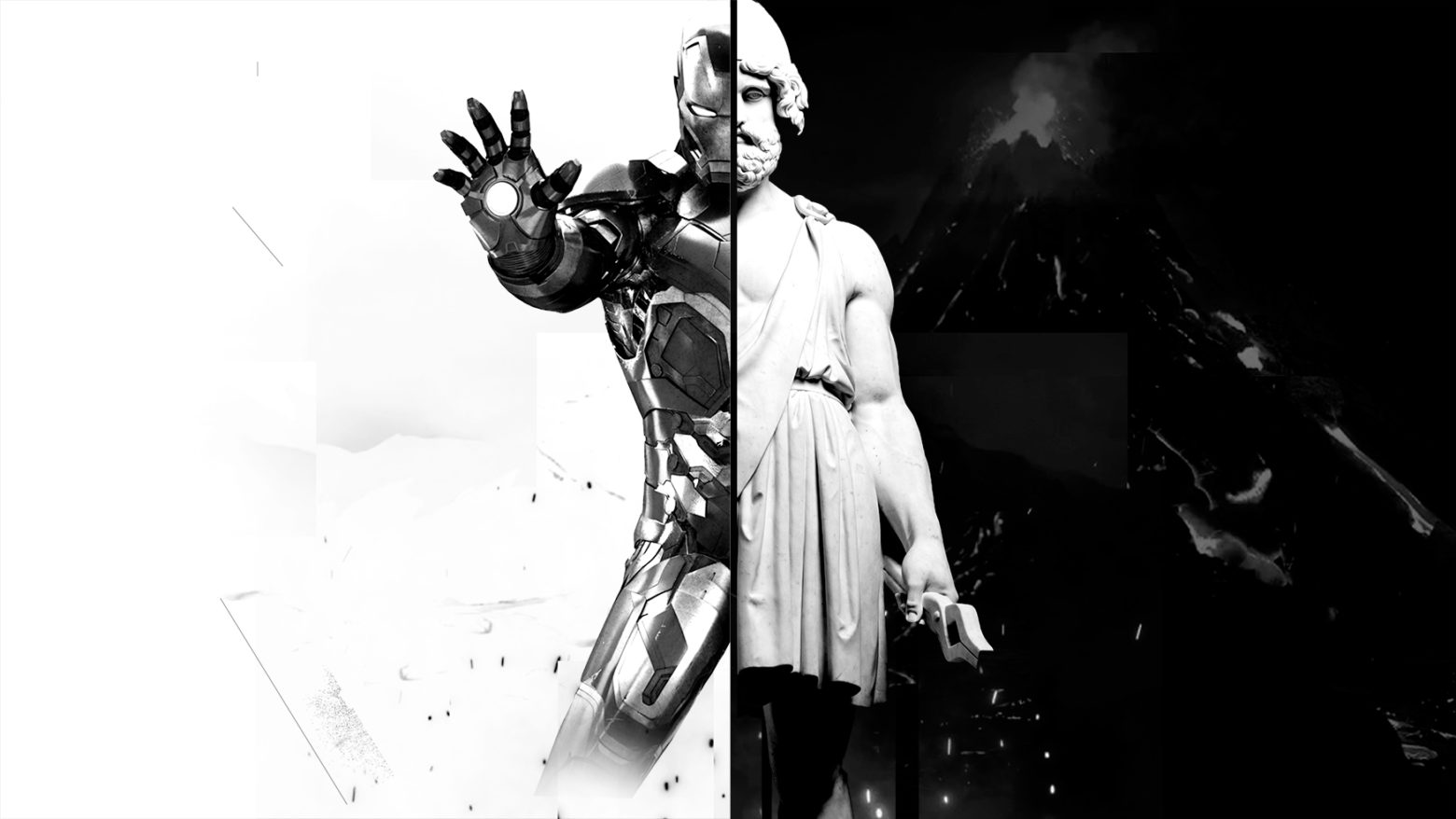Iron Man, craftsman of the Earth’s Mightiest Heroes, epitome of man’s ingenuity – of technological transcendence over human limitation. The Armoured Avenger has long been among the most popular heroes of our time. No surprise there. Tony Stark, whose craftsmanship borders on sorcery, is the perfect image of our modern ambition. Our drive to subdue nature through intellectual mastery over the universe…
And yet there is something quite non-modern about Iron Man. Something timeless draws us in with its mysterious appeal.
This timeless core is Iron Man’s archetypal essence. An idea that has appeared to man in ever new guises throughout time and place.
The Canaanite god Kothar-wa-Hasis, the Egyptian god Ptah, the Hindu Tvastr, the Greek Hephaestus… These are some of the different masks the Iron Man has worn throughout the ages. But underneath there has always raged the same primordial fire.
The fire of the Wounded Craftsman.
So, let’s attempt to lift the mask of the archetype, even if only slightly. Let us attempt a portrait of this ancient force and see how much of ourselves we will discover in it by the time we are done.
(You can watch the video version of this essay on YouTube.)
SPOILERS FROM THE MARVEL CINEMATIC UNIVERSE AHEAD
(and also some from Greek mythology)
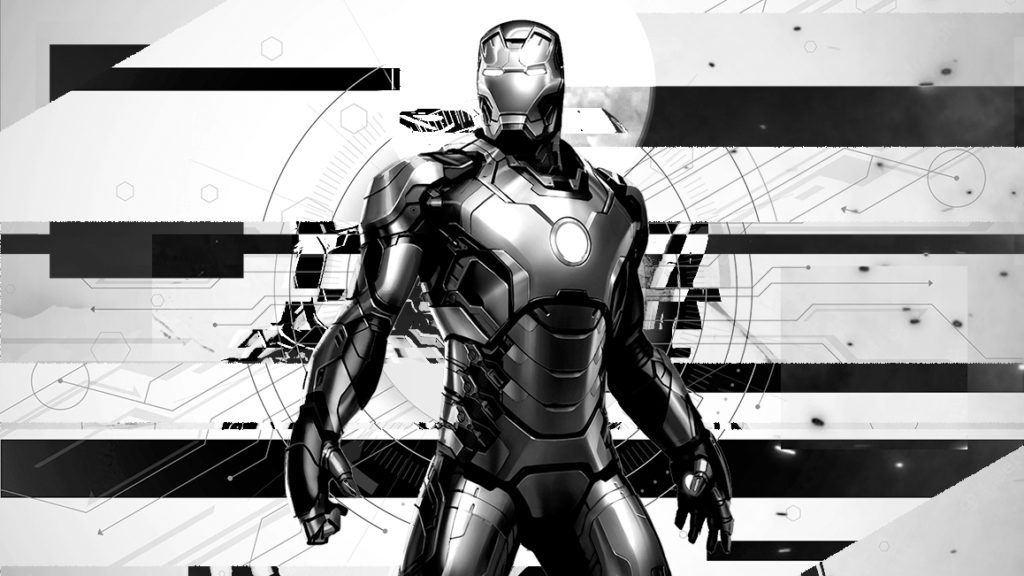
The Legend of Iron Man
Iron Man’s tale is a well-known one, but let’s revisit it briefly. As with any myth, many versions exist, but they all tell the same tale.
Young Tony Stark is the son of billionaire weapons manufacturer Howard Stark. Growing up, Tony exhibits extraordinary intelligence, yet suffers a difficult childhood. Not only is his father a workaholic and an alcoholic – he is also never satisfied with Tony, despite the boy’s achievements.
When still only a youth, the untimely death of his parents leave Tony traumatized for the rest of his life – and the sole inheritor of Stark Industries. The young man buries his grief in work and in a few years turns his father’s company into the world’s leading arms manufacturer. Tony’s life by then is all work, promiscuous sex, and heavy drinking.
But destiny has other plans for him.
During a fateful weapons demonstration, Tony is wounded by shrapnel and kidnapped in enemy territory. Imprisoned in a cave, he has to build an electromagnet into his chest to protect his heart from the shrapnel in his blood. Forced by his captors to build weapons, Tony secretly constructs a suit of armour he uses to escape his prison.
But he steps out of the cave a changed man.
Ending all his arms dealing, Tony makes it his life’s work to upgrade his suit of armour and use it to fight crime. Thus, Iron Man is born.
Equipped with Stark technology and funded by Tony’s wealth, the Earth’s superheroes soon group together into Marvel’s pantheon – the Avengers. Tony goes on to build much of the Avengers’ iconic equipment, such as Captain America’s shield (first designed by Howard Stark). A founding member and one of its leaders, Iron Man remains central to the group until the end of his life.
In the Marvel Cinematic Universe (MCU), this end comes when Tony sacrifices his life to save the universe from total annihilation. This completes Iron Man’s story ark and assimilates him into that great saviour archetype of the West – Christ.
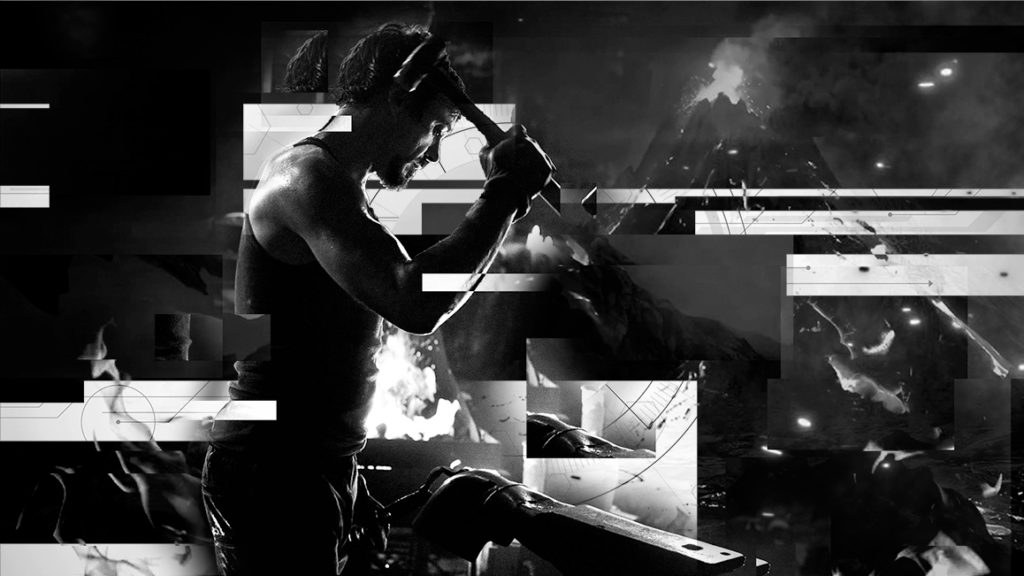
The Wisdom of Trauma
‘Trauma is not the bad things that happened to you, but what happens inside you as a result of what happened to you.’
Gabor Maté, The Wisdom of Trauma
Before we shift our gaze to Hephaestus, a more ancient incarnation of Iron Man, let’s linger on Tony’s story for a moment.
Note how trauma fuels Tony’s actions and motivations throughout his life. Rejected by his father, he compensates for it with his incredible intelligence and industriousness – graduating top of his class at MIT when only 17. Soon after, he loses his parents and again handles it through work. He turns himself into the most successful industrialist on the planet.
This pattern continues after Iron Man is born too.
Following the events of The Avengers movie, where alien invaders nearly destroy New York, Tony develops severe PTSD, suffering from flashbacks, nightmares, and panic attacks. How does he handle it? He locks himself up in his high-tech garage and works manically on new suits of armour. He engineers around 40 different variants, calling them his Iron Legion.
I believe the ‘arc reactor’ Tony builds into his chest to keep himself alive gives us the key to his personality.
We see in Iron Man the continual attempt to use intelligence, creativity, and industriousness as means of coping with trauma – physical and emotional alike. But Tony’s inventions are not simply tools for dealing with pain. They are moulded and fuelled by his suffering.
Just like the fire of the forge transforms raw metal into powerful instruments – so too does Tony transform his suffering into creativity. And so too does fate transform him into Iron Man.
Destruction breeding creation, death breeding life – the alchemical motif of transmutation runs as an undercurrent to Iron Man’s story.
This ancient logic of ritual sacrifice (killing in order to renew life) naturally leads us back to the founding myth of the West, and the ultimate sacrifice. The crucifixion of Christ – the death of the individual allowing for the rebirth of the Cosmos.
That’s exactly how Iron Man’s story culminates on the big screen.
But there is much more to unearth within this rich archetype. To do so, we will need a change of perspective, a look at the ancient roots of Iron Man in the West.
Following the trail of fire and the sound of hammer striking metal, we arrive at a far older forge. The forge of an ancient monstrosity, a repulsive creature that is yet a god. A god of fire and forges, a wounded inventor – and a friend to man.
Hephaestus.
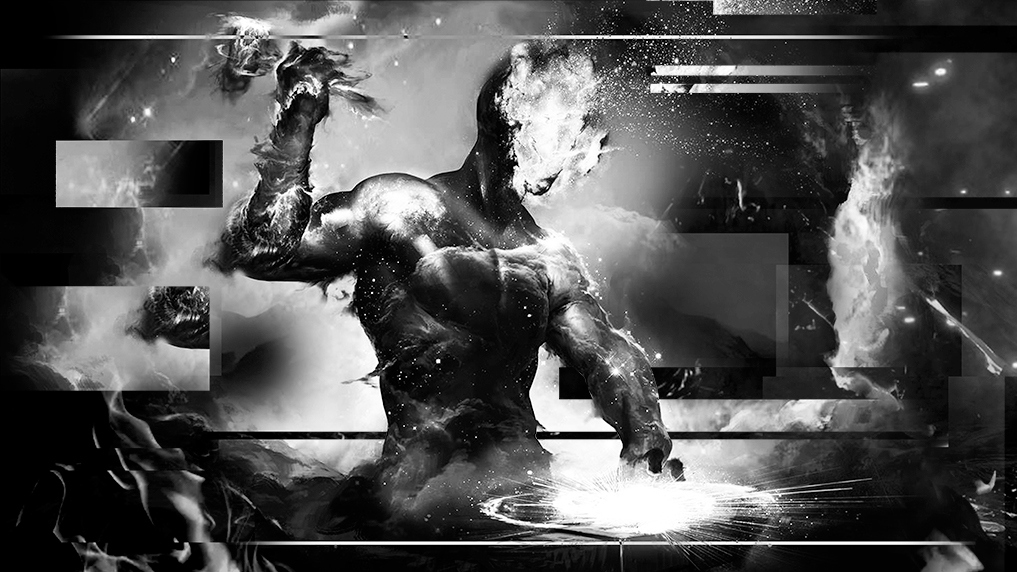
The Myth of Hephaestus
‘He became the smith-god, the great artificer, lord of mechanics. And the mountain always smoked and rumbled with his toil, and he has always been very ugly and very useful.’
Bernard Evslin, Heroes, Gods and Monsters of the Greek Myths
Like Lucifer, Hephaestus is a fallen angel – a rejected god. Born of Hera in a fit of rage, he is cast down from the mountain of the gods by either his mother or father (accounts differ). It is unclear whether he is thrown off Olympus because he is lame or whether his deformities are due to the great fall. Either way – he falls into the sea and remains there for 9 years, nurtured by the sea goddess Thetis. (Compare this with Tony’s subterranean imprisonment.)
One day Thetis shows up on Olympus wearing the most elaborate jewelry the gods had ever seen. Learning that the jewelry is the work of her son, Hera demands that he immediately return to Olympus to work as a craftsman of the gods.
Naturally, Hephaestus is not thrilled about going back to his abusive family.
After the many failed attempts of the gods to draw him out from the sea, it is finally Dionysus, the god of wine, who persuades Hephaestus to return to Olympus. How? Dionysus gets him dead drunk and delivers him to the gods on the back of a donkey.
Reinstated in the pantheon, Hephaestus quickly proves his usefulness by crafting weapons and armour that would go on to become legendary. He crafts Hermes’ winged helmet and sandals, Achilles’ armour… And yes – he forges Zeus’ all-powerful thunderbolt too.
Hephaestus also crafts his famous automatons (*cough* Iron Legion *cough*) – mechanical golden maidservants that are so elaborate as to seem alive and self-aware. His work wins him such renown that Zeus rewards him with the hand of Aphrodite, the goddess of love, in marriage.
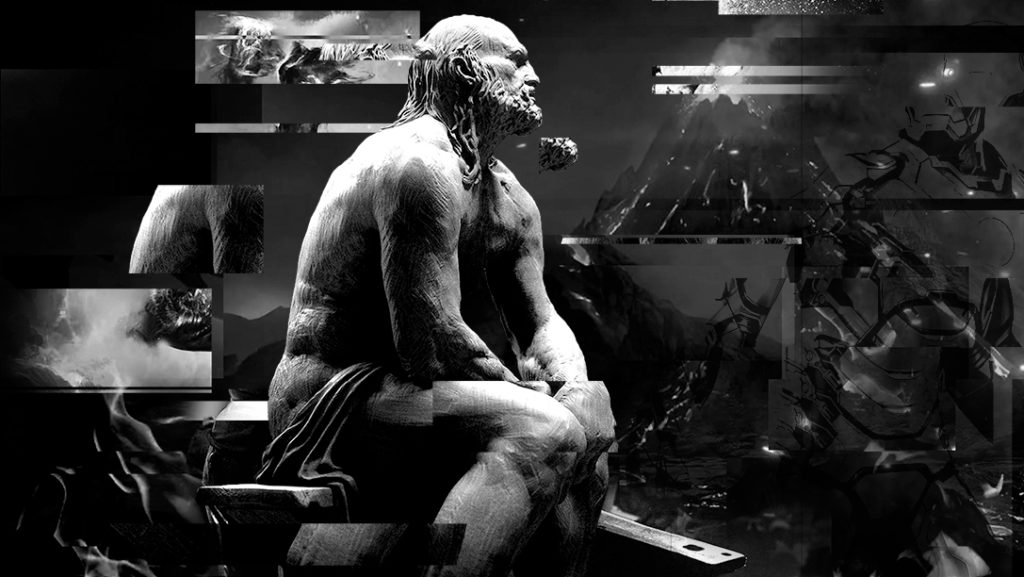
The Unloved God
But not all goes well for ‘The One of Many Devices’. No sooner than he marries the most beautiful goddess, Hephaestus learns of her infidelity with the god of war, Ares.
How does the Divine Smith handle it? The Odyssey tells us:
‘He laid the great anvil on its base and set himself to forge chains that could not be broken or torn asunder, being fashioned to bind lovers fast. Such was the device that he made in his indignation against Ares, and having made it he went to the room where his bed lay; all round the bed-posts he dropped the chains, while others in plenty hung from the roof-beams, gossamer-light and invisible to the blessed gods themselves, so cunning had been the workmanship.’
Homer, Odyssey 8. 267 ff (trans. Shewring) (Greek epic C8th B.C.)
Once Aphrodite and Ares lay down on the bed in love’s embrace, they are caught in Hephaestus’ elaborate net – naked and unable to move. The enraged craftsman returns with the whole of Olympus with him, showing everyone the adulterers caught in the act.
The pattern of rejection punctuates Hephaestus’ story. As the scholar of religion Mircea Eliade tells us, the smith archetype goes hand in hand with social isolation. Like fire, a smith is both invaluable and dangerous to those around him:
‘In archaic societies, smelters and smiths are held to be masters of fire… But the ambivalent character of metal – laden with powers at once sacred and demonic – is transferred to metallurgists and smiths: they are highly esteemed but are also feared, segregated, or even scorned.’
Mirca Eliade, The History of Religious Ideas, Vol. 1
In fact, Hephaestus’ deformity (and Tony’s injuries too) might be rooted in a widespread ancient custom. You see, our ancestors used to intentionally cripple their own smiths and artisans. Why? So that these most valuable assets may not escape to join hostile tribes.
The suffering so elegantly captured in mythical stories is always first lived out by real men of flesh and blood.
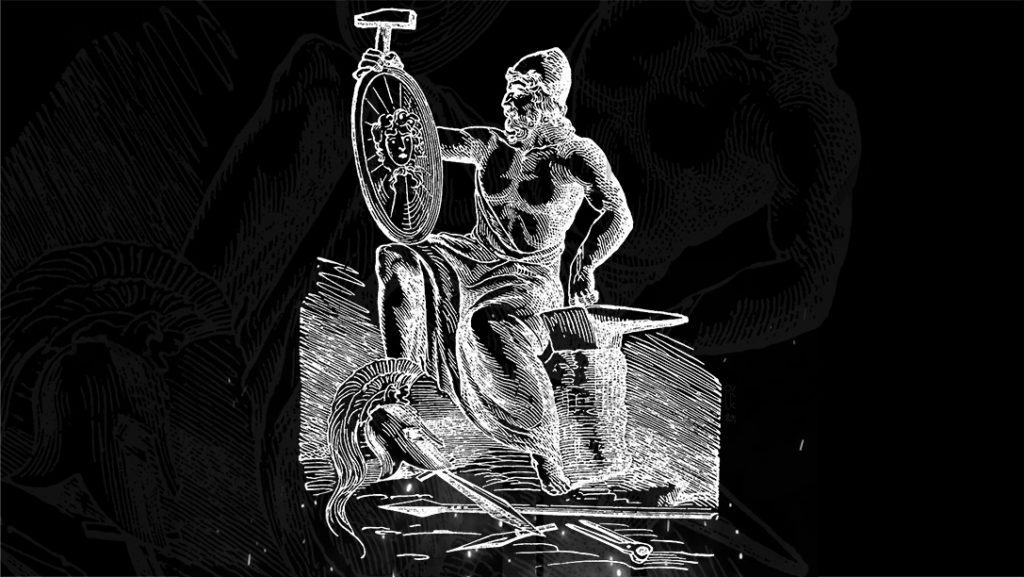
Divine Priest of Technology
As the sole imperfect Olympian, and the only one who has to work to earn his keep – Hephaestus became popular in Ancient Greece as the god who shares in man’s toils. Some modern scholars see in him a prototype of the divine incarnation in man we find perfected in Christ.
Hephaestus was worshiped as a patron of civilized man – of human ingenuity which assures survival and prosperity.
Here is how Greek poets praise him:
‘Sing, clear-voiced Muse, of Hephaestus famed for inventions. [He] taught men glorious crafts throughout the world, men who before used to dwell in caves in the mountains like wild beasts. But now that they have learned crafts through Hephaestus the famed worker, easily they live a peaceful life in their own houses the whole year round. Be gracious, Hephaestus, and grant me success and prosperity!’
Homeric Hymn 20 to Hephaestus (trans. Evelyn-White) (Greek epic C7th to 4th B.C.) :
The hymn is quite clear. As an archetype, Hephaestus is man’s inventiveness that pulls him out of existential insecurity and into higher forms of being. He is the creative force propelling us away from ‘wild beasts’ – into civilization. The god of industry and progress, he gives man victory over the limitations imposed by nature.
But for all these virtues, we should not forget Hephaestus is a lame, ugly, deformed god. In fact, it is this inherent deficiency, this ‘original sin’, that fuels his great achievements and is inseparable from them. This makes him a tragic deity.
Not unlike Sisyphus, Hephaestus is fated to forever chase after new technology with the hope it will deliver him from his insecurities. His works bring him power and renown, but he always ends up back at the forge the next day, toiling at the next great invention.
This makes Hephaestus not only a god – but a religious god. What do I mean by this?
Unlike all other Olympians, who are perfect in and of themselves – Hephaestus chases after transcendence. He pursues a self-overcoming, a leap into a higher ontological plane. He is restless, dissatisfied, hungry for progress. His work, being a maker, is to commune with a reality that does not yet exist and to draw it into being.
The god-smith professes his own private technological religion. In every stroke of his hammer, we hear a prayer:
‘My next work will deliver me from myself’.
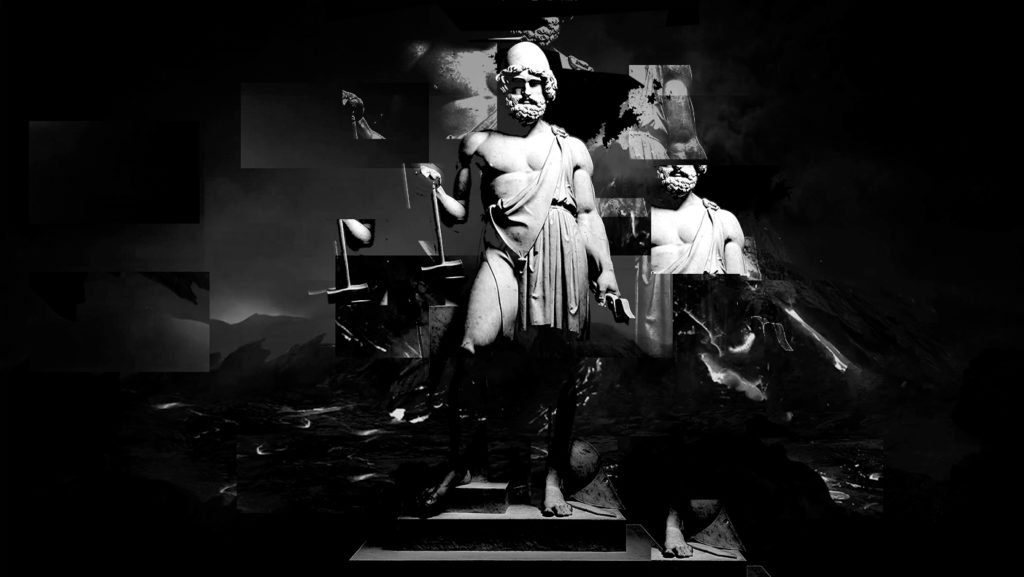
Memento Mori
Beneath the surface, Hephaestus is not only the god of craftsmanship but of what Ernest Becker calls ‘denial of death’. Hephaestus’s creativity is actually secondary to what sets him apart from all other Olympians and brings him closest to man.
That is – he nearly dies.
Here is how the god himself recounts his childhood trauma in the Iliad:
‘‘[Zeus] caught me by the foot and threw me from the magic threshold, and all day long I dropped helpless, and about sunset I landed in Lemnos, and there was not much life left in me. After that fall it was the Sintian men who took care of me’
Homer, Iliad 1. 568 ff (trans. Lattimore) (Greek epic C8th B.C.)
Clearly, Hephaestus’ physical wounds hide much deeper emotional trauma left by his brush with death.
His knowledge of the fear of death, being rejected by the gods – and the work addiction he develops as a coping mechanism… These make the Lame Smith the most human of the gods, a portrait of our mortal insecurities and our desperate attempts to escape from them.
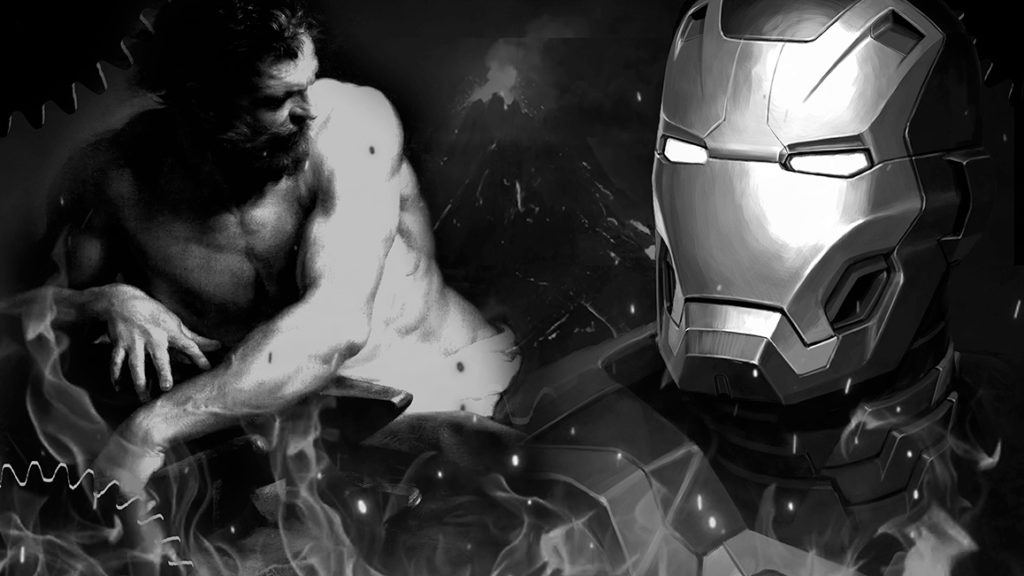
A Story Continued
‘I’m sick of being Iron Man! Sick of having to wear an electronic chest plate 24 hours a day! Sick of living on borrowed time… Never knowing which moment will be my last!‘
Tony Stark, Tales of Suspense Vol 1 56
The creators of Iron Man understood all this, either from their knowledge or, more likely, from their deep intuition into the workings of myth.
Like Hephaestus, the only lame god – Iron Man is the only Avenger without superpowers. The mortally wounded one who, stripped of his armour and technology, is just as helpless in the face of death as any man.
Like his Greek prototype, Tony’s creativity also springs from his encounters with death.
First, it is the death of his parents that sparks his growing Stark Industries. Some years later, his kidnapping and shrapnel wounds produce his first suit of armour and transform him into Iron Man. And after he nearly sacrifices his life to save New York, he develops PTSD for the remainder of his life and begins designing a ‘suit of armour around the Earth’.
But it is Tony’s final embrace of death that crowns him as the hero of our time.
With no clever technology to hide behind, Tony is finally caught up by the choice he has been evading all his life. He has to either face his mortality or lose all he cares about. Really, a choice between maturity and denial, between responsibility and nihilism.
A choice we all have to make.
We can read in this final chapter of Iron Man’s story a sort of initiation. In the end, Tony grows out of his playboy-billionaire-superhero act into the realization of his human limitations. His greatest act of heroism comes not from finally perfecting his technology to the point of transcending nature. It comes from his accepting nature and the fragility of life.
Tony’s last words are ‘I am Iron Man’, but at that moment it is Iron Man who becomes Tony Stark. The armour cracks and the man speaks from within.
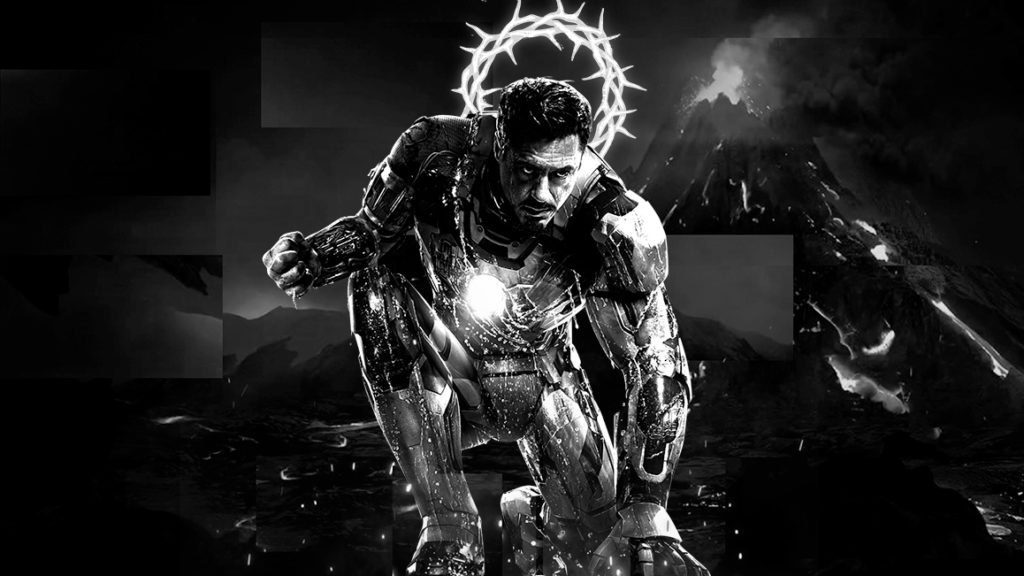
Hephaestus Shrugged
We can see that Iron Man’s story is not simply a reworking of the myth of Hephaestus. Rather, it is its development and completion.
The Greek myths leave Hephaestus in his forge, eternally trying to drown out his existential dread with the sound of his hammer. Not so the American myths.
Marvel gives us the wounded god of the forge brought even closer to man. Indeed, Iron Man is a hero, but a hero in a mortal man’s body. A Christlike incarnation of an ideal into an individual.
The Armoured Avenger inherits all of Hephaestus’ woes. The abandonment issues, the alcoholism, the work addiction, the incapability of maintaining a romantic relationship, the trauma… But he gives a novel answer to the Hephaestian condition which did not occur to our ancestors.
Iron Man is the offspring of pagan Greek mythos and the pop culture of Christian America. Through him, Hephaestus finds himself in a new land and finally matures.
But what is it about our culture that has allowed Hephaestus to grow out of the vicious circle of technological denial of death?
I believe it is the fact we are all collectively living out the Hephaestian tragedy.
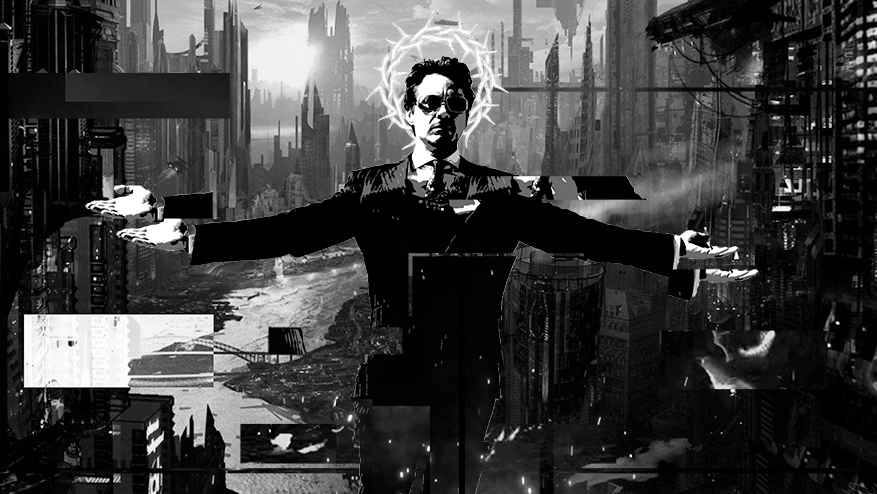
‘Men with their Hammers A-Bleedin’’
‘What cruel trick of fate is this?? I’m one of the strongest, most powerful, most feared humans on the face of the Earth! There is nothing I cannot accomplish… Nothing I would not dare! And yet, I haven’t the courage to remove my iron armor… I don’t dare gamble with my damaged heart! I’m a prisoner of Iron Man… Of my own creation!!‘
Tony Stark, Tales of Suspense Vol 1 60
What is modern man if not the master of technology, industry, and productivity? Before what idols does he prostrate himself more often than Science and Progress? Are we not a family of technophile workaholics, divorcees, and substance abusers? The superb craftsmen, we would rather engineer our own Metaverse and an exodus to the stars than deal with the troublesome reality of living a human life.
Today Hephaestus rages within us like never before. It would not be an exaggeration to say we are possessed by the One of Many Devices. The eternally crippled makers, we toil at crafting a future to deliver us from ourselves. The next iPhone, the next Tesla model, the next movie or album, the next vaccine, the next spike in Bitcoin… Always chasing, always working away at the ‘American Dream’.
This Hephaestian attitude is the very essence of the scientific project and our consumerist economy.
And it is a religious attitude.
There is much talk today of ‘secular modernity’, but we should look more carefully before we proclaim the death of God. As Dylan sings, ‘You got to serve somebody’ – and the fall of one master is always the ascension of the next.
The worship of Science, Technology, and Progress has soaked so deeply into our bones we can no longer distinguish ourselves from it. We can hardly recall a time when life was about something other than producing and consuming more. We look at cultures professing different values and we call them ‘primitive’. We look at people of different faiths and we call them ‘religious’ – our word for ‘heretics’.
But it is we who have fallen into a trap our oldest stories have been always warning us about.
‘Being thrown off Mt. Olympus and coming “down to earth”[, Hephaestus] is like Adam and Eve being thrown out of the Garden of Eden.
‘In both myths, suffering and the need to work results from “the fall.”’
Jean Shinoda, Gods in Everyman
Are we doomed to repeat the Hephaestian tragedy, toiling forever, hammer in hand, against our existential dread? Have we lost the ability to connect with our human fragility and the (im)perfection of nature? Are we forever to chase for salvation in our works and possessions?
Are we forever trapped in an armour of our own making?
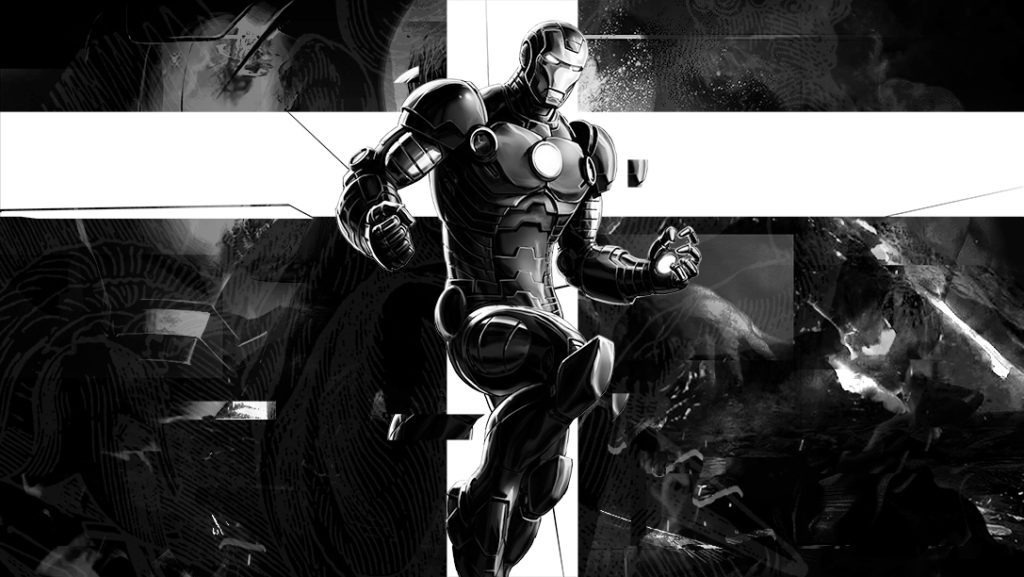
The Golden Avenger
Iron Man, this supreme work of modern mythos, shows us a way out of this mass psychosis.
A way to exorcise the Hephaestian spirit and reclaim our dignity as mortal men.
Just like Christ ‘died for us so that … we may live together with him’ (1 Thessalonians 5:10) – Tony Stark dies on the big screen so that we may imitate his victory.
Victory over what?
Victory over the transhumanist delusion that technology will allow man to escape from being man. The Nietzschean delusion we can craft ourselves into gods.
Most of all, Iron Man’s victory is an affirmation of man’s inherent worth. When his technology, his genius, and his wealth fail him, Tony has one last offering to make.
His life.
Iron Man trades his life for the regeneration of the Cosmos. The life not of a superhero, but of a simple man trying to do good.
Over 20 movies in, the Marvel superhero saga culminates by highlighting the intrinsic worth of mortal man in the face of death. But this worth is not something man must produce or chase after. It is something he needs to rediscover within himself.
Iron Man’s final act is an encouragement to release our frantic hold on technology and heroics. To turn our gaze inward, into our own human, all too human nature. It is there that Tony discovers his supreme power. Man’s only possession worthy of the entire universe – his mortal life.
Repeating Christ’s sacrifice, Iron Man baptizes Hephaestus in blood. Our hyper-Hephaestian age has allowed the pagan god to grow conscious of himself and confront his demons.
The result of this is Iron Man.
Like a modern-day prophet, the Golden Avenger tears down the false idols we worship and points us back to the eternal Law. He shows us the only way to grow out of our trauma is to confront it. And the only way to reclaim our life is to accept mortality.
‘And I swear, as the man, Tony Stark – As the Avenger fate chose to cast in the role of Iron Man – That I will live to avenge those whose lives have been lost through the ignorance of men like the man I once was…
‘Or I will die trying!’
Tony Stark, Iron Man Vol 1 78
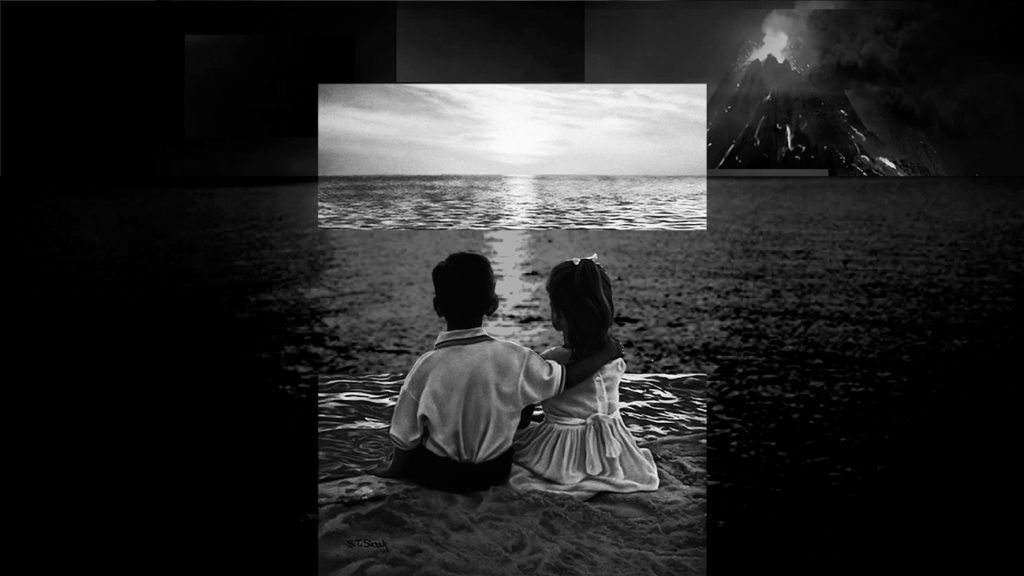
Memento Vivere
Not only will technology and progress not deliver us from death – they can trap us into the infantile fantasy of immortality. They can keep us away from maturing into a deeper understanding of the human condition. They can rob us of the beauty and meaning of knowing our mortal limitations. Knowing our distance from the gods.
Man will never be God, Tony Stark teaches us – so we might as well learn how to fully be men while we have the chance.
This does not entail a denial of the virtues of science and human ingenuity. It does not mean surrendering our thirst for knowledge and power. Rather, it is a more mature standpoint from which to exercise our mind soberly, without falling into pathological addictions to work, possessions, or ideas.
The good news is this is not the private wisdom of Iron Man; nor of Marvel’s writers.
It is our common, collective wisdom, emerging from the struggles of our modern soul to understand itself. As Hans Zimmer puts it, ‘we are all alone in this together’. The stories we tell are the story of each and every one of us, happening always and forever.
But as times progress, even ancient stories may need to transform. Every new age calls forth from man’s heart such things as have never before seen the light of day.
Seeing the aggressive expansion of science and technology, one might think a Hephaestian eclipse has plunged us all into a pagan Dark Age. But look at the stories we tell and you’ll find the soul of man does not submit so easily to false idols.
Our hyper-Hephaestian culture, tempered by our Christian tradition and the wisdom of the human spirit, has given us a new chapter to a timeless story. Hephaestus has grown up into Iron Man. Iron Man has grown down into, simply – man.
Mortal man, who contains the entire Cosmos in his beating heart.

